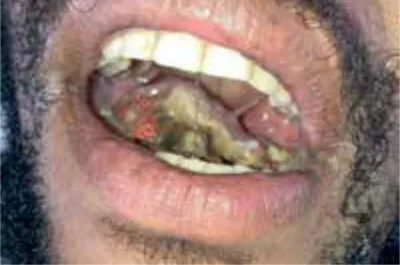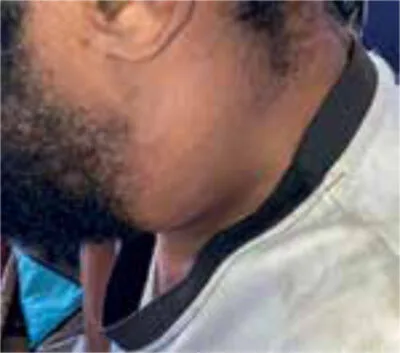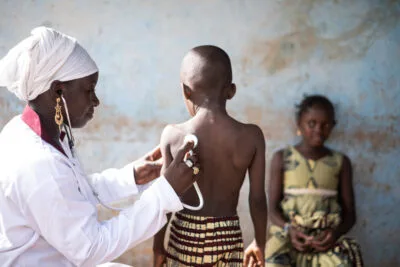Main content
| Case A 26-year-old man, non-smoker and incidental user of beetle nut (also known as Areca nut, the seed of the Areca palm) with no prior history of disease, presents with a swelling in the mouth that existed for 1.5 years and is slowly increasing in size. He lost his ability to talk and can only drink fluids. In addition, in the last month he developed a progressive painful swelling of 10 by 10 centimetres on the left side of the neck, making it almost impossible to move his head. He has lost an unspecified amount of weight; there was no history of fever or night sweats. He has visited various health centres for this problem and received antibiotics without any improvement. On physical examination, there is an ulcerating tumorous mass in the oral cavity. Large parts of the tongue and the floor of the mouth are destructed. The dental area looks normal (Figures 1,2). An ultrasound of the neck showed a fluid collection on the left and enlarged lymph nodes. A fine needle aspiration of the swelling of the neck showed mixed pink, straw-coloured fluid. Ziehl-Neelsen examination of the mouth ulcer and the lymph node aspirate for acid-fast bacilli (AFBs) was negative. The medical doctor in charge made a differential diagnosis of a malignancy, cancer, noma (also known as necrotizing ulcerative stomatitis), tuberculosis or any (dentogenic) infectious problem and consulted the Consult Online panel for help. |
Setting
This case is from Kikori, a rural village in Papua New Guinea and is set in a small jungle hospital. Two Physicians Global Health and Tropical Medicine (PGHTM) are running the hospital, which has 100 beds. The infrastructure in the province is poor as roads and electric-ity are non-existent or unreliable. Most trans-portation is by boat, and twice a week a small airplane connects to the capital, where there are more healthcare facilities; the airfare is too expensive for the majority of the population.
Specialist advice
The specialists of the Consult Online panel diagnosed this as a primary mouth floor carcinoma with regional metastases. Further distant metastases could not be ruled out because of lack of facilities. The swelling of the neck could not be clearly diagnosed with this scarce information but could be a (nec-rotizing) metastatic lesion or an abscess.
The specialists’ advice was to perform a biopsy. Functionally and technically an operation seemed impossible. In a high-income setting, combined chemotherapy and radiotherapy would be considered after proper histological diagnosis (see below). In a setting with limited resources, palliative care seemed the only option.
For the differential diagnosis, noma would probably not cause lymph node enlarge-ment such as in this case. Tuberculosis may have unusual clinical presentations, but the patient did not have fever and repeated diagnostic tests for AFBs were negative. A dental focus seems unlikely since the den-tal area looked normal on examination.
Oral cavity carcinoma
The oral cavity extends from the vermil-lion border of the lips anterior to the border of the hard to soft palate cranially and cir-cumvallate papilla of the tongue caudally. Cancer of the oral cavity can therefore involve any of these anatomic structures.[1]
The most common malignancy that occurs in the oral cavity is squamous cell carcinoma (SCC), accounting for 90-95% of such cases. Squamous cell carcinoma is the sixth most common form of cancer worldwide.[2] Less common are cancers of the salivary glands, sarcomas, or osteosarcomas originating from the mandible.[1] SCC of the oral cavity has a high incidence in Southeast Asia, Europe, and the United States (Figure 3). Common risk factors are the use of tobacco, alcohol, exposure to environmental pollutants, immune deficiency, and infections of the oropha-ryngeal cavity, for example with human papillomavirus (HPV) or Epstein-Barr virus (EBV). The high prevalence in the United States and Europa is increas-ingly associated with infections of the oropharyngeal cavity with HPV, whereas the prevalence of oral SCC in Southeast Asia seems associated with a specific cultural habit.[3] Here, a specific risk factor is the use of beetle quid, a local mixture of areca nut, beetle leaf, slaked lime and tobacco that is often chewed on and has mild stimulating effects. The carcinogen source in this mixture is Areca catechur.[1,2,3]
Oral SCC usually presents with invasion followed by destruction of local tissue. Lymph node metastases are common, but a presentation with distant metasta-ses is unusual. A biopsy or fine needle aspiration is needed for diagnosis. After the diagnosis is made, TNM staging of the tumour is necessary to choose the right treatment. Early-stage oral SCC can, depending on resources, be treated by surgery or definitive radia-tion therapy, with or without concurrent chemotherapy, depending on tumour margins and risk of locoregional relapse. Because of common lymph node metas-tases, early staging and (elective) treat-ment should be done through sentinel lymph node biopsy, (elective) lymph node dissection or radiation therapy.[1]
Follow up
Microscopic examination of fine needle aspiration stained with Giemsa stain was suggestive of squamous cell carcinoma. The painful swelling in the neck was most likely a necrotizing lymph node. The patient in this case had inadequate financial resources for optimal treatment in the capital; palliative care was given. The swell-ing in the neck was aspirated several times for pain relief; this was repeated multiple times. Finally, based on local experience, he was discharged home with a short course of metho-trexate and painkillers, after which he did not return to the hospital.



Contact: c/o MTredactie@nvtg.org
References
- Uptodate. Treatment of stage I and II (early) head and neck cancer: The oral cavity. [Internet]. Available from: https://www-Iuptodate-Icom-10019d29b20f4.hanhosting.vakliteratuur.info/contents/treatment-of-stage-i-and-ii-early-head-and-neck-cancer-the-oral-cavity. [Accessed 4th March 2022].
- Panarese I, Aquino G, Ronchi A, et al. Oral and oropharyngeal squamous cell carcinoma: prognostic and predictive parameters in the etiopathogenetic route. Expert Rev Anticancer Ther 2019, 19(2), 105-119.
- Johnson DE, Burtness B, Leemans CR, et al. Head and neck squamous cell carcinoma. Nat Rev Dis Primers. 2020, Nov 26; 6(1):92. doi: 10.1038/s41572-020-00224-3.

















































